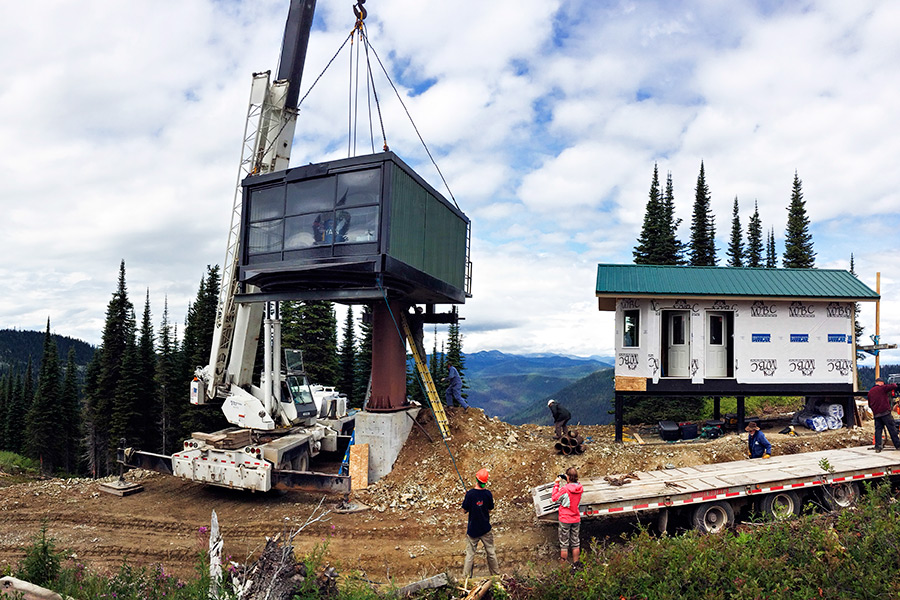Mark Haselby has helped install seven chair lifts on Big Mountain and about 70 across North America during his decades-long career. Few were as rugged as his latest project, tucked in a forested labyrinth on the far corner of Whitefish Mountain Resort’s north side.
“It’s pretty remote back here,” Haselby said last week, standing atop the freshly cleared mountaintop known as Flower Point.
Haselby and his crew are in the final stages of constructing the new Flower Point ski lift, a long envisioned project dating back nearly 20 years that is coming together in time for the upcoming winter. The resort’s $1.29 million addition will include a new triple chair lift that travels 3,486 feet, including 970 feet of vertical rise. Previous managers had proposed a similar project that was approved in 1995, but attention was redirected to Hellroaring Basin and other additions, and the Flower Point project was shelved until now.
According to resort spokesperson Riley Polumbus, the new lift will operate daily during the ski season, similar to Chair 7, which is located only a few hundred yards from the bottom of the Flower Point lift. With a capacity of 1,500 people per hour, the lift will grant easy access to six fresh-cut intermediate runs, as well as the lift line.
“It’s just something that will make our big mountain even bigger,” Polumbus said.
The excitement surrounding the new project comes alongside some concern that the new lift could, in the worse case, lead to dangerous avalanches in the adjacent backcountry.
Located on the resort’s backside in an area that consistently receives an abundance of long-lasting snow, Flower Point has been a popular destination for skiers eager to hike a few minutes into powder stashes that attract less attention. The tract also happens to be the doorstep of Canyon Creek, an out-of-bounds southeast-facing section of the Whitefish Range with thrilling terrain for both skiers and snowmobilers but also high avalanche danger. It’s not uncommon for skiers to take advantage of the resort’s open boundary policy and duck the rope into the canyon for a few laps, but unlike terrain inbounds, the drainage is neither patrolled nor managed for avalanche safety.
In January 2008, several people from the resort were skiing in the canyon when someone triggered a large slide in an area known as Fiberglass Hill. Two men, Anthony Kollmann, 19, of Kalispell, and David Gogolak, 36, of Whitefish, were killed.
Last winter, a snowmobile triggered a slide in one of the canyon’s chutes. The avalanche was 900 feet wide and flooded debris and snow down to the Canyon Creek Road, the main thoroughfare for recreationists. Four people were partially buried but survived.
“I think it’s nice that our ski resort progresses in search of new terrain. (The Flower Point chair lift) will butt up to a section outside of our ski resort that will be easier to access than it has been in the past,” said Craig Moore, an avid local skier and organizer of the Northern Rockies Avalanche Safety Workshop, an annual event that raises awareness and funds for avalanche safety in the Flathead Valley.
“I feel like it will change the dynamics of the canyon for sure, good and bad.”
Moore’s concern, along with others’, centers on a higher volume of people adventuring in the backcountry unprepared and unaware of the dangers.
“More people will have easy access to our wonderful backcountry. With that comes the responsibility of doing it safely and treating it solely as the backcountry,” he said. “People need to be responsible for their actions. These are high consequence actions we take.”
Polumbus agrees. With the resort expanding mainstream access to the edge of its boundary, there needs to be heightened awareness and information regarding the backcountry, she said.
“People look at this as something special and different, and it’s true because the terrain back there just happens to be an avalanche terrain trap,” she said.
The resort plans to clearly mark the ski boundary with signs and ropes the same way it does all other boundaries. The resort is also working with the U.S. Forest Service and backcountry avalanche awareness groups to develop a concerted strategy for addressing the issue of entering the backcountry from the resort, including informational signs that clearly explain dangers associated with avalanches and unpatrolled areas.
“That way it becomes an educational and historical point of reference. That might deter somebody from going back there, or make them think twice,” she said.
On Aug. 25, crews poured the concrete for each of the 17 lift towers, and helicopter crews prepared to fly in the individual pieces. A new patrol shack is planted at the top of the chair lift, where scenic views create an impressive panorama of Glacier National Park and the surrounding valley. The section’s new runs have already been cleared and named, except for one yet to be named after community stalwart Norm Kurtz, who passed away last winter.
Whitefish Mountain Resort is slated to open for skiing Dec. 6.
